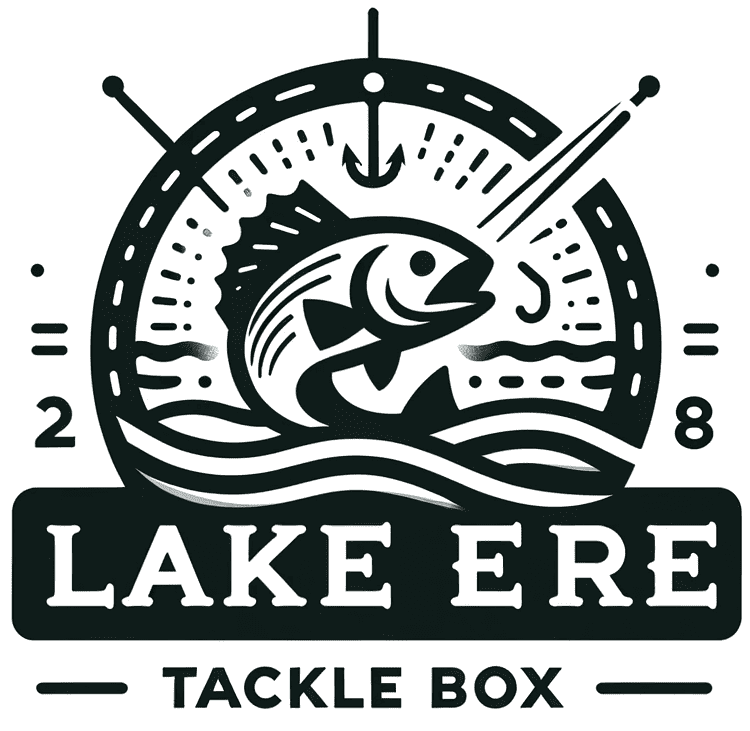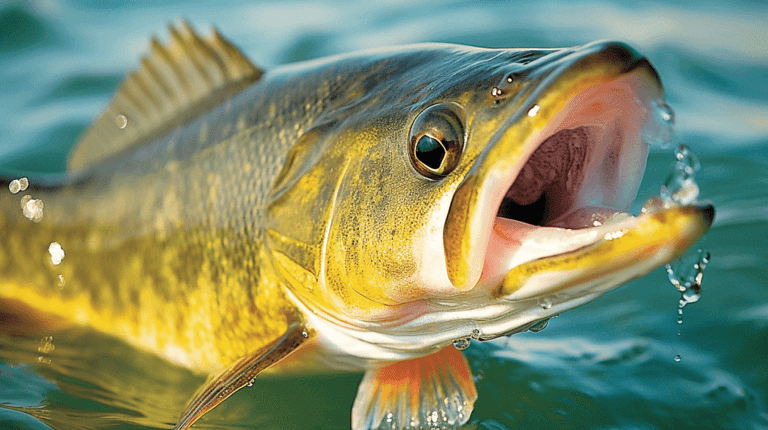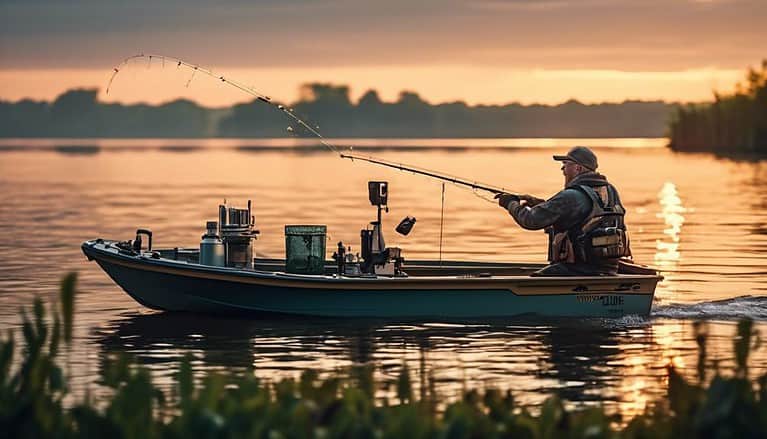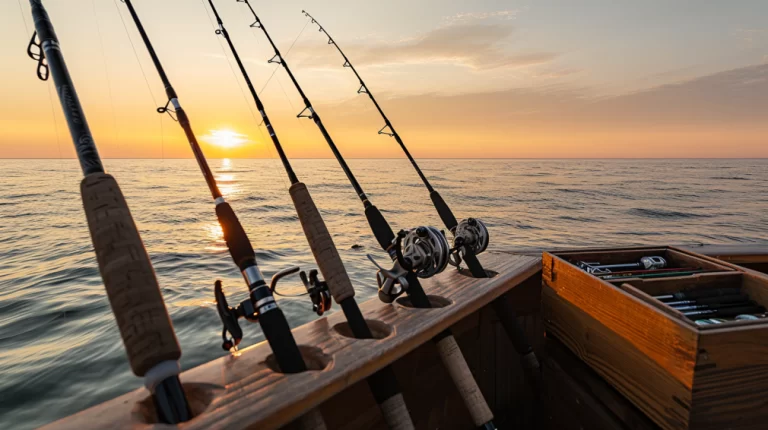Bass Fishing in Lake Erie: Proven Techniques and Hotspots
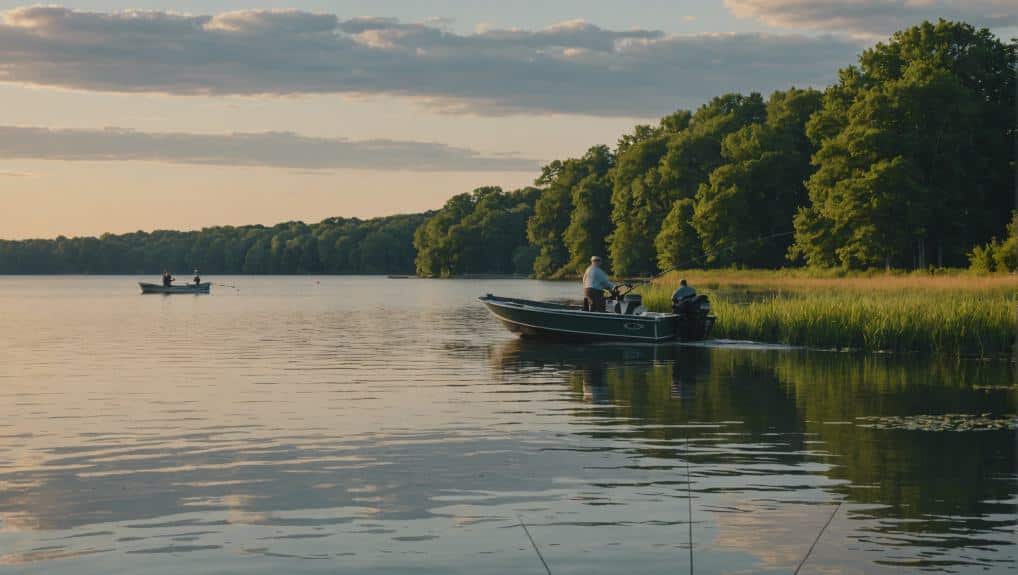
Lake Erie offers top-tier smallmouth bass fishing, especially in its Western Basin. Use drop-shot rigs for precise bait placement and crankbaits to cover extensive areas. Tube baits that mimic gobies are also effective. Late spring to early fall is prime fishing season, with mid-June through July being peak. For hotspots, consider areas around Kelleys Island and Presque Isle Bay. Equip yourself with medium-heavy rods and 10 lb fluorocarbon leaders for best results. Tuning your strategies to match seasonal patterns and local conditions will greatly enhance your success—there’s much more to discover about Lake Erie’s unique bass fishing experience.
Main Points
- Focus on the Western Basin’s structures for excellent smallmouth bass fishing.
- Use drop-shot rigs with finesse worms for precise bait presentation.
- Target late spring to early fall for peak bass fishing action.
- Employ tube baits and crankbaits to cover large areas and attract bass.
- Visit Kelleys Island and Presque Isle Bay for top fishing locations.
Table of Contents
Overview of Lake Erie
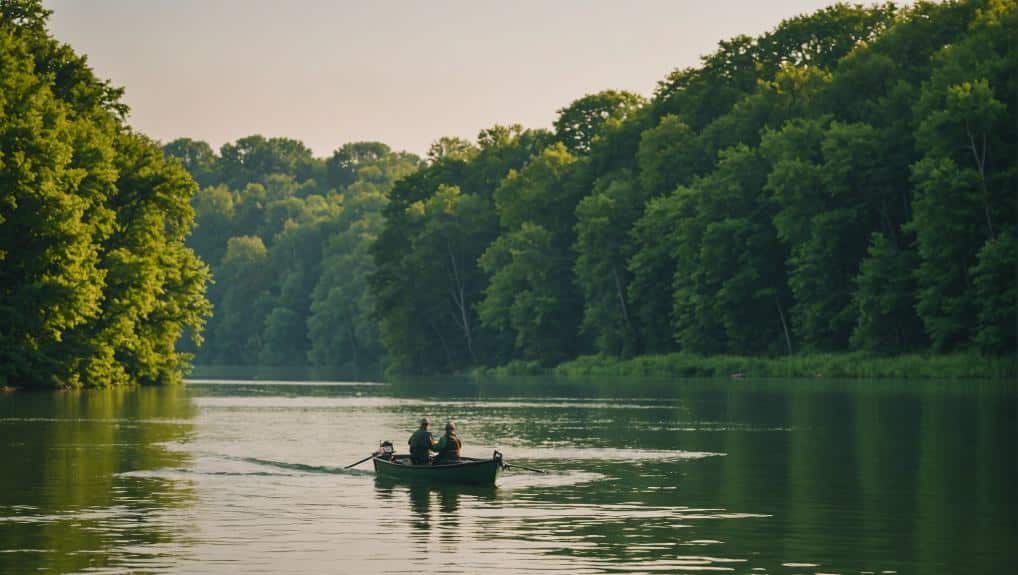
Lake Erie’s vast expanse of nearly 10,000 square miles and diverse basins make it an angler’s paradise, particularly for those targeting bass. As the fourth largest of the Great Lakes, it offers a variety of fishing experiences across its three distinct basins: the shallow western basin, the deeper and wider central basin, and the eastern basin. Each basin presents unique hotspots and challenges for bass anglers.
If you’re seeking smallmouth bass, Lake Erie is unrivaled. The lake’s structure, including shallow humps, points, and underwater flats in 15 to 25 feet of water near islands and marsh areas, is ideal for this bass species. The shallow western basin is especially productive, known for its rich vegetation and plentiful baitfish.
Practical advice for maximizing your success includes scouting areas with rocky substrates and submerged structures where smallmouth bass tend to congregate. Local anglers frequently target these areas, as the lake’s record smallmouth bass weighed an impressive 10.15 pounds.
Best Fishing Techniques
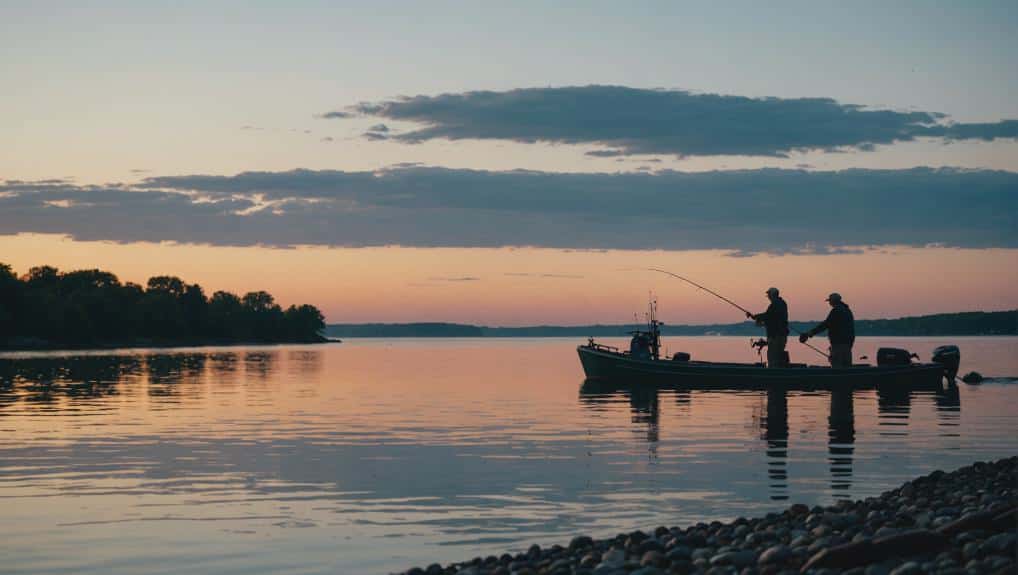
To maximize your chances of landing a trophy smallmouth bass on Lake Erie, start by mastering the use of drop-shot rigs, crankbaits, and tube baits. These techniques are essential for targeting different depths and structures within the Western Basin, where smallmouth bass thrive.
Early spring is particularly fruitful, as the bronze smallmouth bass become more active. Using drop-shot rigs allows you to present your bait precisely in front of the fish, making it hard for them to resist. Crankbaits are effective for covering large areas quickly and triggering reaction strikes.
Tube baits mimic gobies, a favorite smallmouth snack, making them irresistible. Blade baits and jerkbaits are also exceptional choices, especially when the water is cooler.
- Drop-shot rigs: Perfect for precise bait presentation.
- Crankbaits: Ideal for covering large areas and provoking strikes.
- Tube baits: Mimic gobies and appeal to smallmouth bass.
- Blade baits and jerkbaits: Great options in cooler water.
Focus your efforts on the Western Basin, where diverse fishing opportunities await. Whether you’re casting near rocky structures or fishing deeper waters, these techniques will help you connect with those prized smallmouth bass.
Prime Fishing Seasons
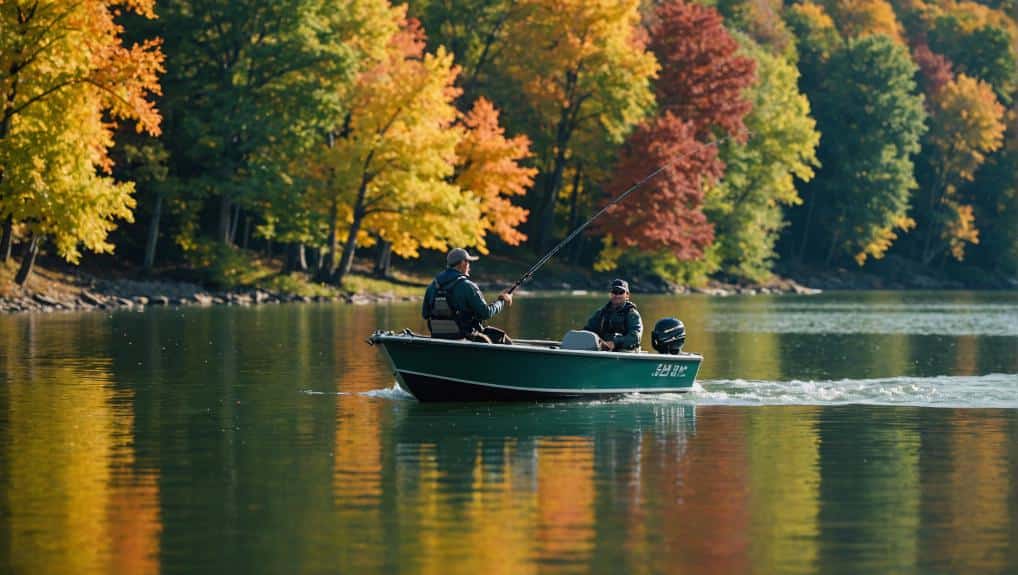
You’ll find the best bass fishing on Lake Erie from late spring to early fall, with peak action often hitting in mid-June through July. During this period, smallmouth bass fishing is particularly rewarding due to the ideal water temperatures and abundant schools of bait. As the water warms up, bass become more active, making it easier to locate and hook them.
In late spring, prespawn bass are a prime target. These fish are feeding aggressively in preparation for spawning, typically found in shallower waters. Areas of change and irregularities in the bottom contour are hotspots during this time, as bass congregate in these areas to ambush prey.
When fall arrives, Lake Erie fishing remains productive. Early fall sees bass moving back to shallower waters, chasing schools of bait as they fatten up for the winter. The cooling water temperatures trigger this feeding frenzy, offering excellent opportunities for anglers. Focus on areas where the bottom contour changes, as these spots often hold large numbers of fish.
Top Fishing Locations
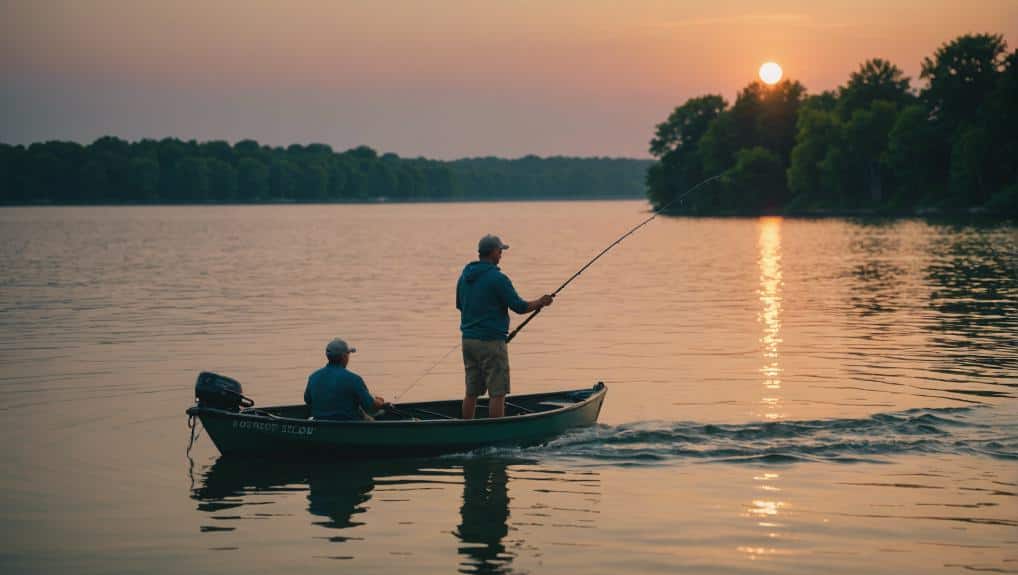
As the seasons dictate the behavior of bass, knowing the top fishing locations on Lake Erie can greatly enhance your chances of a successful catch. The Western Basin is a prime spot, renowned for its excellent smallmouth bass fishing opportunities. Here, you’ll find shallow humps and underwater flats that attract bass, particularly in depths of 15 to 25 feet. Target these structures for a rewarding fishing experience.
Presque Isle Bay in Erie, PA, is another hotspot. This area is favored for its deeper waters and consistent current, making it ideal for smallmouth bass. The bay offers a variety of fishing opportunities across different depths and structures.
Don’t overlook Kelleys Island. Its surrounding waters are rich with smallmouth bass, particularly around points and underwater flats. This spot is well-known among local anglers for its productive fishing grounds.
To maximize your fishing success, consider these top locations:
- Western Basin: Shallow humps and underwater flats in 15-25 feet of water.
- Presque Isle Bay: Deeper waters and current-rich areas.
- Kelleys Island: Points and underwater flats.
- Island Adjacent Areas: Numerous structures offering varied fishing opportunities.
These locations promise a fruitful fishing adventure on Lake Erie.
Gear and Tackle Recommendations
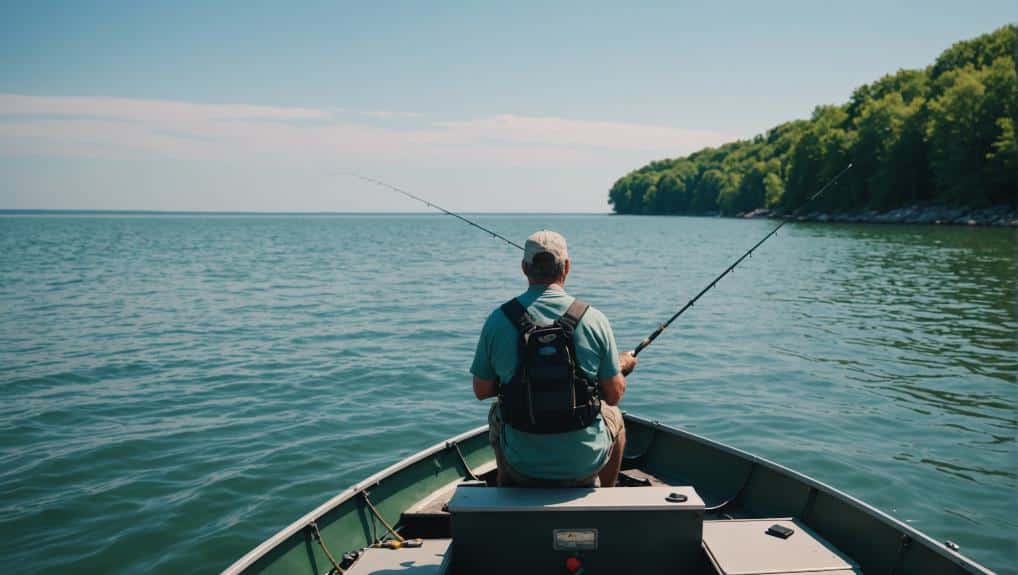
When fishing for Lake Erie bass, it’s important to have the right equipment. Start with a medium-heavy rod paired with either 12 lb fluorocarbon or 17 lb monofilament to handle the zebra mussels.
For lures, you have a few go-to options for trophy smallmouths. Swimbaits, medium and deep diving crankbaits, and flipping jigs are all effective choices.
Don’t forget to use a 10 lb fluorocarbon leader with finesse worms to entice tentative biters and pull big bass from cover.
Essential Rod and Reel
To successfully fish for smallmouth bass on Lake Erie, equip yourself with a medium-heavy rod and a 10 lb fluorocarbon leader for best control and durability. This combination ensures you can handle tentative biters and extract large bass from cover without compromising sensitivity or strength.
The medium-heavy rod provides the backbone needed to battle hefty smallmouths, while the fluorocarbon leader offers excellent abrasion resistance, vital for dealing with zebra mussels that are prevalent in Lake Erie.
When choosing your rod and reel setup, consider the following:
- Rod Length and Action: A 7-foot medium-heavy rod with fast action helps with accurate casting and better hook sets.
- Reel Quality: A high-quality spinning reel with a smooth drag system enhances your ability to fight fish and manage line.
- Line Selection: While a 10 lb fluorocarbon leader is great, also keep 12 lb fluorocarbon or 17 lb monofilament lines handy to combat zebra mussels and snags.
- Backup Gear: Always have a backup rod and reel in case of equipment failure, ensuring you’re never caught off guard.
Best Lure Choices
For Lake Erie bass fishing, prioritizing versatile lures like swimbaits, crankbaits, and jigs will greatly enhance your chances of landing both smallmouth and largemouth bass.
Swimbaits and spinnerbaits are particularly effective for largemouth bass, especially in vegetation-rich areas such as reed lines and hydrilla beds. When targeting smallmouth bass, medium and deep diving crankbaits can help you cover more water and find active fish.
In addition, using blade baits can be incredibly effective in colder water conditions, mimicking the erratic movement of baitfish. The Ned rig, paired with finesse worms, excels in pressured waters and can entice tentative biters.
Drop shot rigs are another must-have, allowing you to present your lure right in the strike zone of suspended bass.
Tailoring lure size to match Lake Erie’s forage base is essential. Larger baits can attract trophy-sized bass, while smaller offerings might yield more consistent action.
A medium-heavy rod paired with a 10 lb fluorocarbon leader is recommended for pulling bass out of cover and detecting subtle bites.
Line and Leader Tips
Choosing the right line and leader setup can make a substantial difference in your Lake Erie bass fishing success, especially when dealing with zebra mussels and rocky terrain. To maximize your chances of landing trophy smallmouth bass, here’s what you need to know:
- Use 12 lb fluorocarbon: This line offers excellent abrasion resistance and sensitivity, perfect for the rocky areas where smallmouth bass are abundant.
- Try 17 lb monofilament: If you’re concerned about snags and zebra mussels, the sturdier 17 lb monofilament line can help prevent break-offs.
- Opt for a 10 lb fluorocarbon leader: This leader is ideal for tentative biters and provides the strength needed to pull large bass out of cover.
- Match your setup to the conditions: Adjusting your line and leader to the specific conditions and target species can significantly enhance your success rate.
Fluorocarbon lines are particularly advantageous when bass fishing in Lake Erie due to their superior abrasion resistance and sensitivity. These traits make them ideal for detecting subtle bites and maneuvering the rough, rocky bottom where smallmouth bass often hide. By tailoring your line and leader setup to these local conditions, you’ll be better equipped to handle the unique challenges of Lake Erie bass fishing.
Popular Lures and Baits
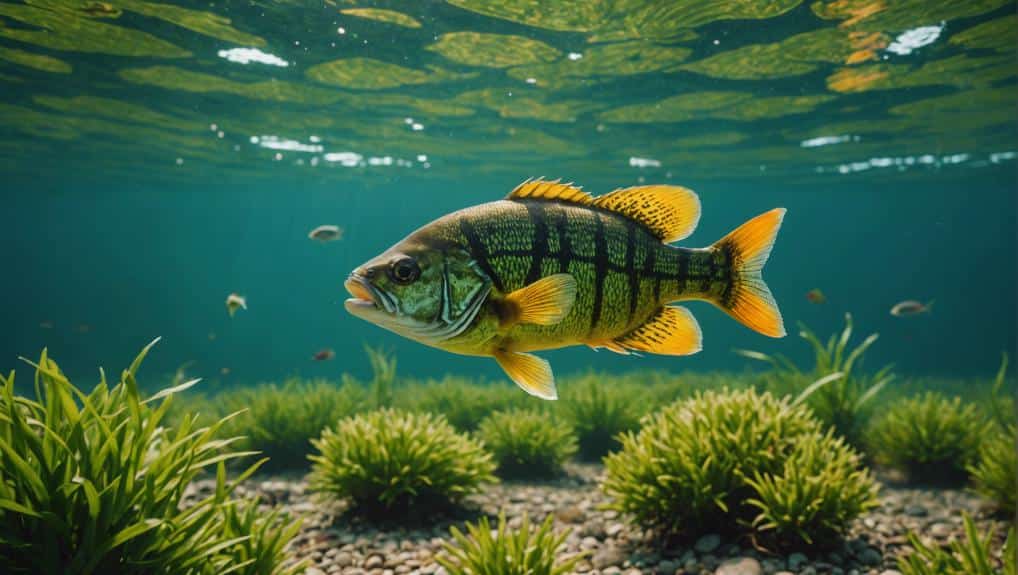
When you’re fishing for smallmouth bass in Lake Erie, leveraging tube baits like the Yamamoto Senko can greatly boost your success rate. Tube baits mimic the lake’s forage and are perfect for enticing bass hiding among rocky structures.
Drop-shot rigs with finesse worms or minnow-type soft plastics are another surefire method. These rigs excel in deeper waters where smallmouth bass often lurk.
Blade baits, such as the Steel Shad, are indispensable during colder months. Their tight vibrations attract bass from a distance.
Crankbaits, like the DT-10, are versatile, allowing you to cover various depths and structures effectively. Use them to probe around ledges and submerged structures where bass wait to ambush prey.
Soft plastic jerkbaits, such as the Yamamoto D Shad, are fantastic for targeting postspawn smallmouth bass. Their lifelike action in the water can provoke aggressive strikes. Vary your retrieve speed and let the bait dart and pause to mimic a distressed fish.
Expert Fishing Tips
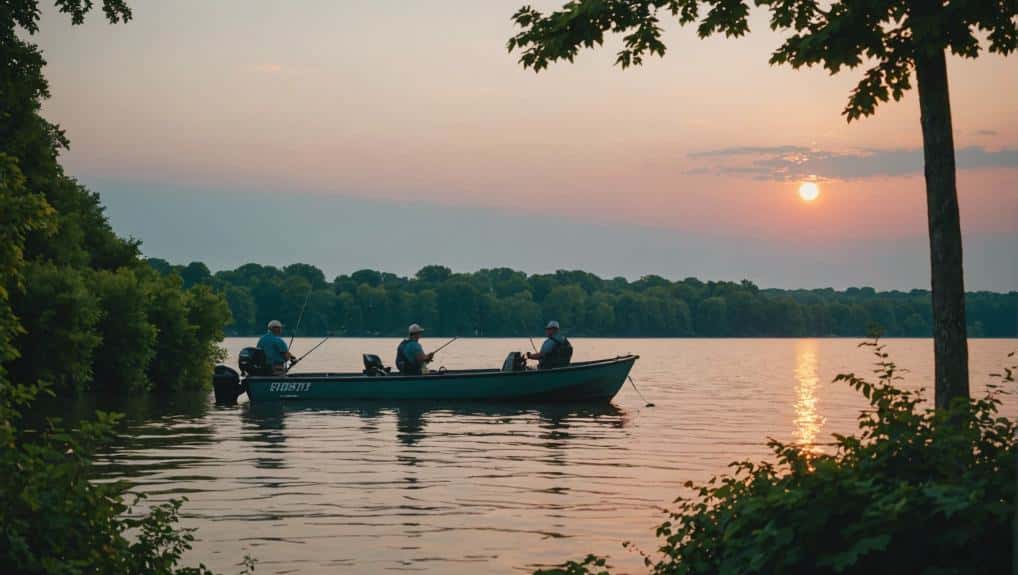
To consistently catch smallmouth bass on Lake Erie, focus on understanding their seasonal patterns and preferred habitats. Expert anglers emphasize the importance of adjusting your techniques according to the time of year.
Here’s some expert advice to help you land more fish:
- Prespawn: Use Steel Shad blade baits and drop-shot rigs. Crankbaits, jerkbaits, and tube baits are particularly effective in the bay area.
- Spawning Season: Target bedding smallmouth with flipping tubes and soft plastic jerkbaits like the Yamamoto D Shad.
- Postspawn: D Shad baits and topwater walking baits, such as the Rapala Skitter Walk, are your go-to choices.
- Summer: When the water warms up, smallmouth bass move to deeper waters. Drop-shot rigs with finesse worms are highly effective in depths of 40 to 50 feet.
Understanding these seasonal shifts and adapting your techniques accordingly can make a significant difference in your success rate on Lake Erie.
Regulations and Licensing
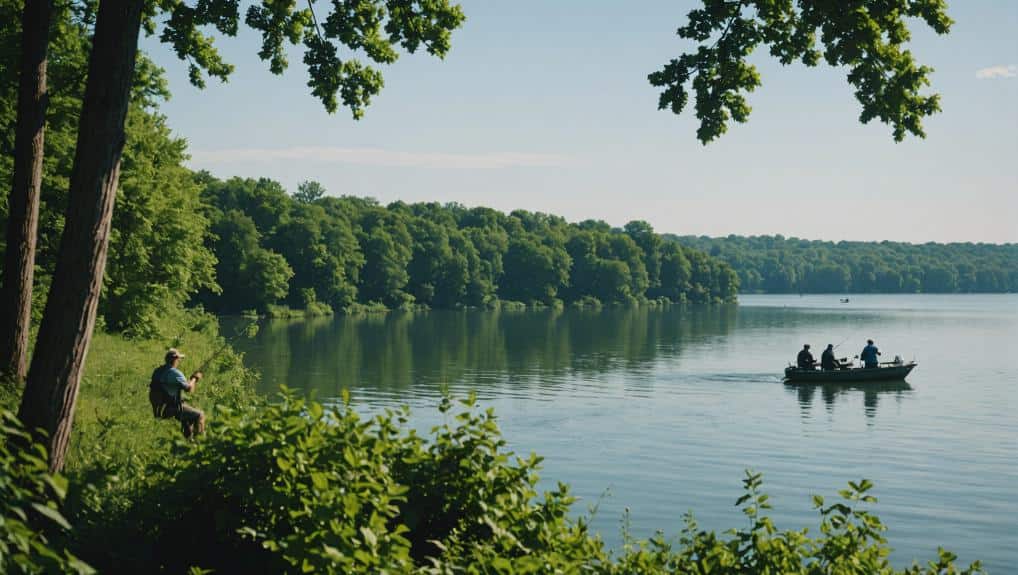
Before heading out to fish in Lake Erie, make sure you’ve got the right permit, as requirements vary between states and Canada.
You’ll also need to be aware of seasonal fishing restrictions that can impact where and when you can fish.
For added convenience, you can often obtain licenses online, ensuring you’re fully compliant with local regulations.
Lake Erie Fishing Permits
Understanding the fishing permit requirements on Lake Erie can be straightforward if you grasp the specific regulations set by Ohio, Pennsylvania, New York, and Ontario. Each jurisdiction has its own set of rules, so knowing what applies to your chosen fishing area is essential.
When planning your trip, keep these essentials in mind:
- Fishing Permits: A valid fishing license is required to fish legally on Lake Erie. Always check the respective state or provincial regulations.
- Trout Stamps: If you’re targeting Trout or Salmon species, you’ll need additional trout stamps, which can be purchased along with your fishing license.
- Canadian Waters: Anglers venturing into Canadian waters must carry a valid passport, Canadian Outdoors Card, and appropriate fishing license.
- Licensing Options: Both sport and conservation licenses are available, with various durations to suit your fishing plans in both US and Canadian waters.
Seasonal Fishing Restrictions
While obtaining the proper fishing permits is essential, understanding the seasonal fishing restrictions for bass in Lake Erie guarantees you’re fishing within legal and conservation guidelines. Bass fishing in Lake Erie is subject to specific regulations that vary throughout the year. These restrictions, including closed seasons and catch limits, are designed to protect fish populations and promote sustainable fishing.
During certain times of the year, there are closed seasons when bass fishing is prohibited to allow for spawning and population recovery. It’s vital to be aware of these periods to avoid penalties and contribute to conservation efforts.
Additionally, catch limits are enforced to prevent overfishing. These limits can vary, so it’s wise to check current regulations before heading out.
Different areas of Lake Erie may also have special regulations, such as designated zones with varying size and creel limits. Staying informed about these localized rules ensures you’re compliant and helps protect the ecosystem.
Always review the latest updates on regulations and licensing requirements from the relevant state or provincial authorities. By adhering to these guidelines, you’ll enjoy a responsible and legal bass fishing experience on Lake Erie.
Conclusion
Imagine standing on the sun-dappled shores of Lake Erie, feeling the tug of a trophy bass on your line. You’ve got the know-how: the best techniques, prime seasons, and hotspots are all at your fingertips.
With the right gear, lures, and local insights, you’re set for success. Remember to stay updated on regulations and secure your license.
Now, cast your line, and let Lake Erie’s abundant waters reward your efforts. Tight lines and happy fishing!
